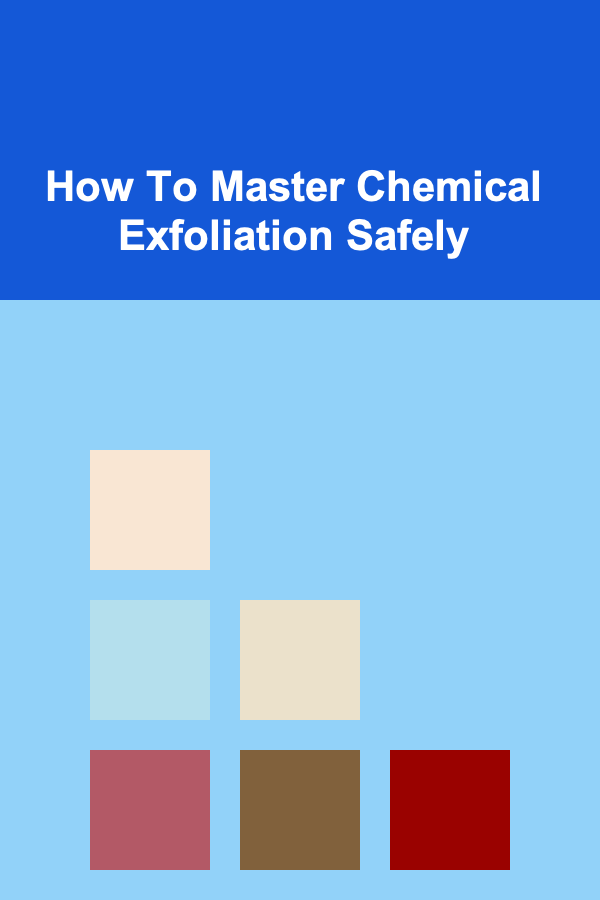
How To Master Chemical Exfoliation Safely
ebook include PDF & Audio bundle (Micro Guide)
$12.99$8.99
Limited Time Offer! Order within the next:

Chemical exfoliation has become an essential part of many skincare routines, offering a way to remove dead skin cells and promote smoother, healthier-looking skin. Unlike traditional exfoliation methods, such as scrubbing with physical particles, chemical exfoliation uses active ingredients like acids to break down the bonds between skin cells. While chemical exfoliation can provide numerous benefits, including brighter skin, improved texture, and better absorption of skincare products, it can also cause irritation, burns, or excessive dryness if not used correctly. In this comprehensive guide, we'll delve into how to master chemical exfoliation safely, ensuring that you enjoy its benefits without harming your skin.
Understanding Chemical Exfoliation
Chemical exfoliation involves the use of active ingredients, most commonly acids, to break down the bonds between dead skin cells, allowing them to shed more easily. Unlike physical exfoliants, which rely on abrasives (such as sugar, salt, or beads) to slough off dead skin, chemical exfoliants penetrate the skin and dissolve the "glue" holding the cells together.
There are two primary types of chemical exfoliants:
1.1. Alpha Hydroxy Acids (AHAs)
AHAs are water-soluble acids derived from fruits, milk, or plants. They work by exfoliating the skin's surface, removing the top layer of dead skin cells. The most common AHAs include:
- Glycolic Acid: Derived from sugarcane, glycolic acid is one of the most potent AHAs. It penetrates the skin deeply, making it ideal for those looking for significant exfoliation.
- Lactic Acid: Found in milk and fruits, lactic acid is milder than glycolic acid and can be a better option for sensitive skin.
- Citric Acid: Derived from citrus fruits, citric acid helps brighten the skin and can assist with pigmentation issues.
- Malic Acid: Sourced from apples and pears, malic acid is gentler than glycolic acid, making it more suitable for people with sensitive skin.
1.2. Beta Hydroxy Acids (BHAs)
BHAs are oil-soluble acids, meaning they can penetrate deeper into pores, making them ideal for oily and acne-prone skin. The most common BHA is:
- Salicylic Acid: Salicylic acid is the most well-known BHA, often used to treat acne, blackheads, and whiteheads. It penetrates deep into the pores to clear out excess sebum and prevent breakouts.
Benefits of Chemical Exfoliation
When used correctly, chemical exfoliation offers several benefits:
2.1. Smoother Skin Texture
By removing dead skin cells, chemical exfoliants reveal fresh, healthy skin underneath. This can improve the overall texture, leaving the skin feeling smoother and more even.
2.2. Brighter Complexion
Dead skin cells can make the skin appear dull and tired. By removing these cells, chemical exfoliation helps reveal brighter, more radiant skin.
2.3. Enhanced Absorption of Skincare Products
When dead skin cells are removed, your skincare products can penetrate the skin more effectively. This means moisturizers, serums, and other treatments work better, giving you more noticeable results.
2.4. Improved Acne and Hyperpigmentation
BHAs like salicylic acid can help treat acne by deep-cleaning pores and reducing inflammation. AHAs can also help fade hyperpigmentation, such as dark spots and acne scars, by encouraging cell turnover.
Risks of Chemical Exfoliation
Despite its many benefits, chemical exfoliation comes with some risks. It's important to be aware of these to avoid negative consequences.
3.1. Over-Exfoliation
Using chemical exfoliants too frequently or in too high a concentration can cause over-exfoliation. Symptoms of over-exfoliation include redness, irritation, dryness, peeling, and sensitivity. This can weaken the skin's barrier and make it more prone to damage.
3.2. Skin Sensitivity and Irritation
Some individuals may experience irritation, especially those with sensitive skin or those who use strong acids. Signs of irritation include stinging, burning, and redness. If this occurs, it's important to stop using the product and give your skin time to recover.
3.3. Increased Sun Sensitivity
Chemical exfoliation can make your skin more sensitive to the sun. Without the protective layer of dead skin cells, your skin is more vulnerable to UV damage. This can result in sunburns, pigmentation, and premature aging.
3.4. Chemical Burns
Improper use of chemical exfoliants, especially in high concentrations, can lead to chemical burns. These burns may cause intense pain, redness, and blisters, requiring medical attention.
How to Safely Master Chemical Exfoliation
To reap the benefits of chemical exfoliation without causing harm, follow these guidelines to master the process safely:
4.1. Start Slow and Patch Test
If you're new to chemical exfoliation, it's crucial to start slow. Begin with products containing lower concentrations of acids to allow your skin to adjust. Start by using the product once a week and gradually increase the frequency as your skin becomes accustomed to it.
Before applying any new product to your face, always perform a patch test. Apply a small amount of the exfoliant on a discreet area, such as behind your ear or on your wrist. Wait for 24 to 48 hours to see if any adverse reactions occur. If you experience irritation, itching, or redness, do not use the product on your face.
4.2. Choose the Right Acid for Your Skin Type
Select the right chemical exfoliant for your skin type and concerns. For example:
- Oily or acne-prone skin: Choose BHAs like salicylic acid, which penetrate deep into the pores to help reduce excess oil and prevent breakouts.
- Dry or sensitive skin: AHAs, such as lactic acid or glycolic acid, can provide gentler exfoliation without irritating the skin.
- Hyperpigmentation or sun damage: AHAs are often effective at reducing dark spots and promoting an even skin tone by accelerating cell turnover.
4.3. Avoid Mixing Too Many Acids
Using multiple exfoliating acids in your skincare routine can be harsh on the skin. Avoid combining strong AHAs and BHAs in the same routine, as this can lead to irritation and over-exfoliation. Stick to one exfoliant per routine and be cautious when layering with other active ingredients.
4.4. Follow the Instructions
Always follow the product's instructions carefully. Different exfoliating products have varying concentrations of acids and specific instructions for use. For instance, some chemical exfoliants are leave-on treatments, while others are meant to be rinsed off after a few minutes. Adhering to these instructions is vital to avoid potential damage.
4.5. Protect Your Skin with Sunscreen
After using a chemical exfoliant, your skin will be more vulnerable to sun damage. Therefore, it's essential to apply a broad-spectrum sunscreen with SPF 30 or higher every morning, even on cloudy days. This will protect your skin from harmful UV rays and prevent further pigmentation issues or sunburns.
4.6. Moisturize and Hydrate
Exfoliating can sometimes leave the skin feeling dry or tight. To counteract this, follow up with a moisturizer to help restore hydration and maintain the skin's moisture barrier. Look for moisturizers containing ingredients like hyaluronic acid, ceramides, or peptides for maximum hydration.
4.7. Don't Overdo It
Less is more when it comes to chemical exfoliation. Over-exfoliating can lead to irritation, redness, and a compromised skin barrier. For most people, exfoliating 2-3 times a week is sufficient. If you're unsure about the frequency, consult with a dermatologist to determine the best routine for your skin.
Choosing the Right Chemical Exfoliant for Your Needs
The market is flooded with a variety of chemical exfoliants, so it can be difficult to choose the right one. Here's a breakdown of some of the most popular products and their uses:
5.1. Exfoliating Toners
Exfoliating toners are a great option for those looking to add a gentle exfoliant to their routine. They are typically used after cleansing and before applying serums or moisturizers. Look for toners with mild AHAs, like lactic acid, or BHAs like salicylic acid if you have acne-prone skin.
5.2. Exfoliating Serums
Serums are more concentrated than toners and often contain higher concentrations of exfoliating acids. If you're targeting specific skin concerns like hyperpigmentation or acne, an exfoliating serum may be more effective. Just be cautious about using other potent actives in the same routine.
5.3. Exfoliating Masks
Exfoliating masks are usually left on the skin for a short time, ranging from 5 to 15 minutes. They offer a more intensive exfoliation and are best used once a week. Many exfoliating masks contain a combination of AHAs and BHAs for a more comprehensive exfoliation.
Conclusion
Chemical exfoliation is an incredibly effective way to refresh your skin and improve its overall appearance. However, it's essential to approach it with caution to avoid irritation or damage. By starting slowly, choosing the right products for your skin type, and following the proper steps, you can safely enjoy the many benefits of chemical exfoliation. Always remember to prioritize sunscreen and hydration, as these steps are crucial to maintaining the health and safety of your skin. With patience and consistency, you'll be able to achieve smoother, clearer, and more radiant skin.

How To Convert Leads into Loyal Customers
Read More
How to Create a Vintage-Inspired Home Decor for Less
Read More
How to Have a Family Storytelling Session Before Bed
Read More
How to Make Your Home Safe for Elderly or Vulnerable Family Members
Read More
Smart Ways to Break the Habit: Cutting Down on Impulse Buying
Read More
The Customer Service Representative's Guide to Exceptional Client Interactions
Read MoreOther Products

How To Convert Leads into Loyal Customers
Read More
How to Create a Vintage-Inspired Home Decor for Less
Read More
How to Have a Family Storytelling Session Before Bed
Read More
How to Make Your Home Safe for Elderly or Vulnerable Family Members
Read More
Smart Ways to Break the Habit: Cutting Down on Impulse Buying
Read More